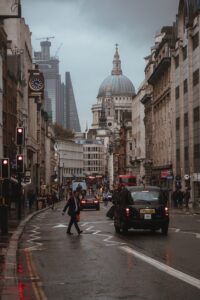It’s the Treasury… all their fault.
Actually, the Treasury is only a building. It’s been around for a long time. Since 1240. In 1698, it burned down when a servant aired bed linen too close to the fire.
Replaced in 1734, and got bombed in 1940.
The public seldom get a chance to see the ‘The Drum’, the internal, elegant courtyard, whose provenance is to be found in designs by the architect Palladio.
The staircase is impressive but much of the wide open interiors were boxed-off, into offices and 580 fire places ripped out.
Despite its history, it only manages a Grade ll listing despite another make-over in 2002. In 1990, the, then, Chancellor, Norman Lamont, likened the Treasury’s ambiance to a Russian psychiatric hospital. After the make-over, he said it was like a Marriott hotel.
Whatever… it’s only a building, so when someone says ‘the Treasury don’t agree‘, what they really mean is; somebody, we don’t know who, doesn’t agree.
I don’t like that. I’m happy when decisions go for, or against, something that I would champion, provided I get a well reasoned argument. Maybe I don’t agree but don’t treat me like an idiot. I can make a fool of myself without any outside help, thank you!
Right now the NHS is facing a huge problem created by ‘The Treasury’ and it is a problem for a group of people who are not attracting much sympathy. The group are high-end-paid doctors.
People earning over £100k don’t get us weeping tears of sympathy but they have a huge problem and it has become a problem for us all. People for whom we would shed tears of sympathy.
The problem? Some medics are facing unexpected tax bills of over £80,000.
People saving for retirement benefit from tax relief on what is paid into, or saved-up, in a pension, subject to annual and lifetime limits. The standard annual allowance is £40,000, which is more than adequate for most average earners.
Pension savings in excess of the allowance face a tax charge, payable at the same rate as an individual’s rate of income tax.
However, in 2016, new curbs were introduced on tax relief for the UK’s top earners who benefit from the lion’s share of government incentives for pension saving.
The so-called, tapered-annual-allowance gradually reduces the annual allowance from £40,000 to just £10,000 for the very highest earners.
Complex rules, governing how the taper is applied, coupled with the inflexibility of the NHS pension scheme, where individuals have little control over their employer’s contributions, have led to thousands of staff, doctors, nurses and senior managers, receiving a tax penalty – often as the result of taking on extra shifts to help manage the workforce crisis in the Service.
The Treasury need to fix it because the up-shot is, consultants are reluctant to take on waiting list work, or fill rota gaps, because they can end up not only earning next to nothing but actually falling into tax penalty.
Trust employers are being encouraged, by the DH+, to use what are little more than clunky fiddles, to get around the rules… and that is hardly an ethical, long-term solution.
The real solution is ‘The Treasury’… the rules have to be changed.
Understandably doctors are not going to pay the NHS to do a shift and there are over four million, of our fellow citizens, waiting for elective treatment.
Some will die before they can take their turn. There are rota gaps for senior clinicians that make some care dangerously under doctored.
There is a saying; two things are certain, death and taxes… it’s not, death because of taxes.
The Treasury is only a building. The Chancellor of the Exchequer is Sajid Javid, a man seeking election. The First Lord of the Treasury is the Prime Minister, also looking to keep his job.
Forget holding the linen too close to the fire, there are some people’s feet that need to be held a bit closer to the fire.
Have a good weekend.
News and Comment from Roy Lilley
Contact Roy – please use this e-address roy.lilley@nhsmanagers.net
Reproduced at thetrainingnet.com by kind permission of Roy Lilley.








